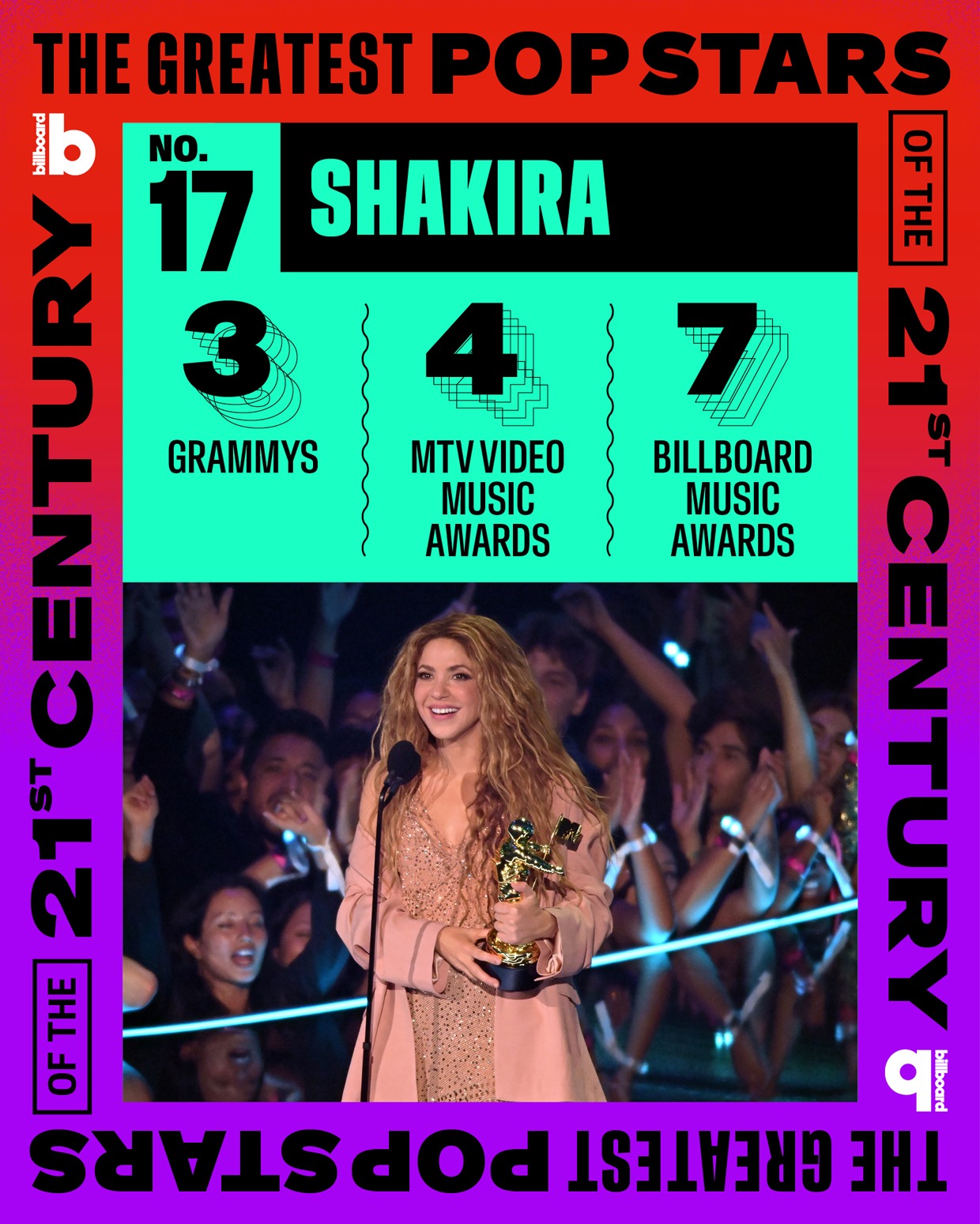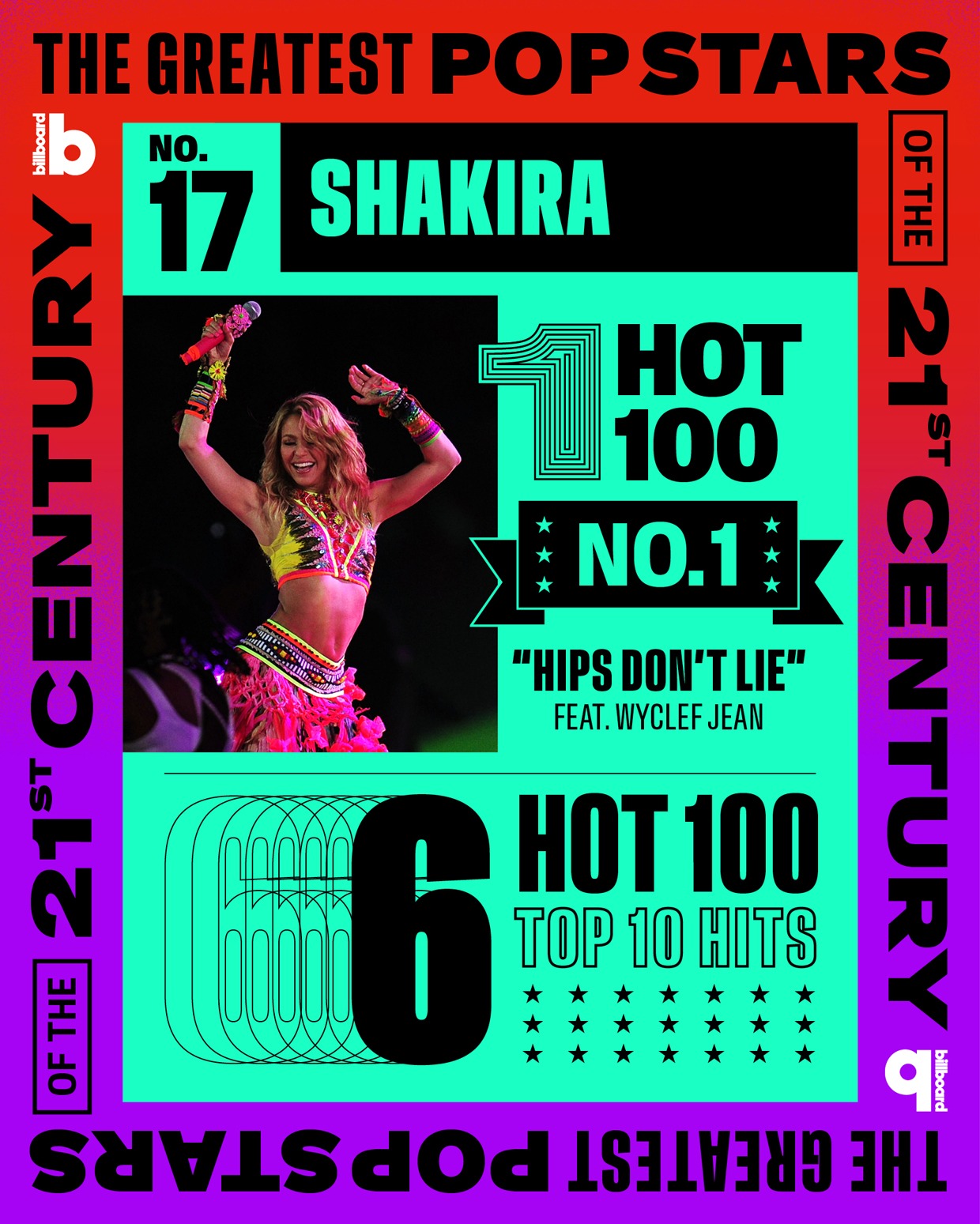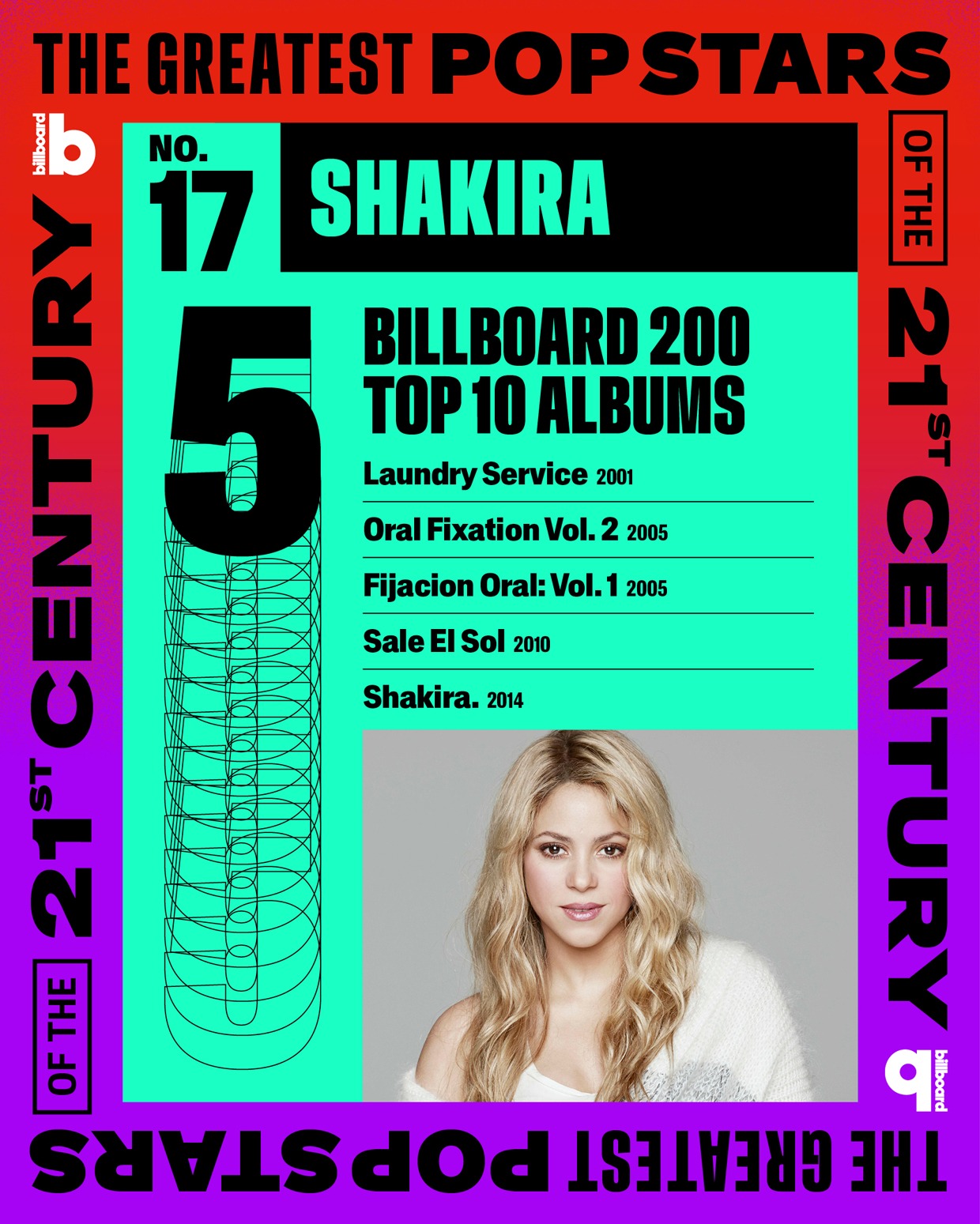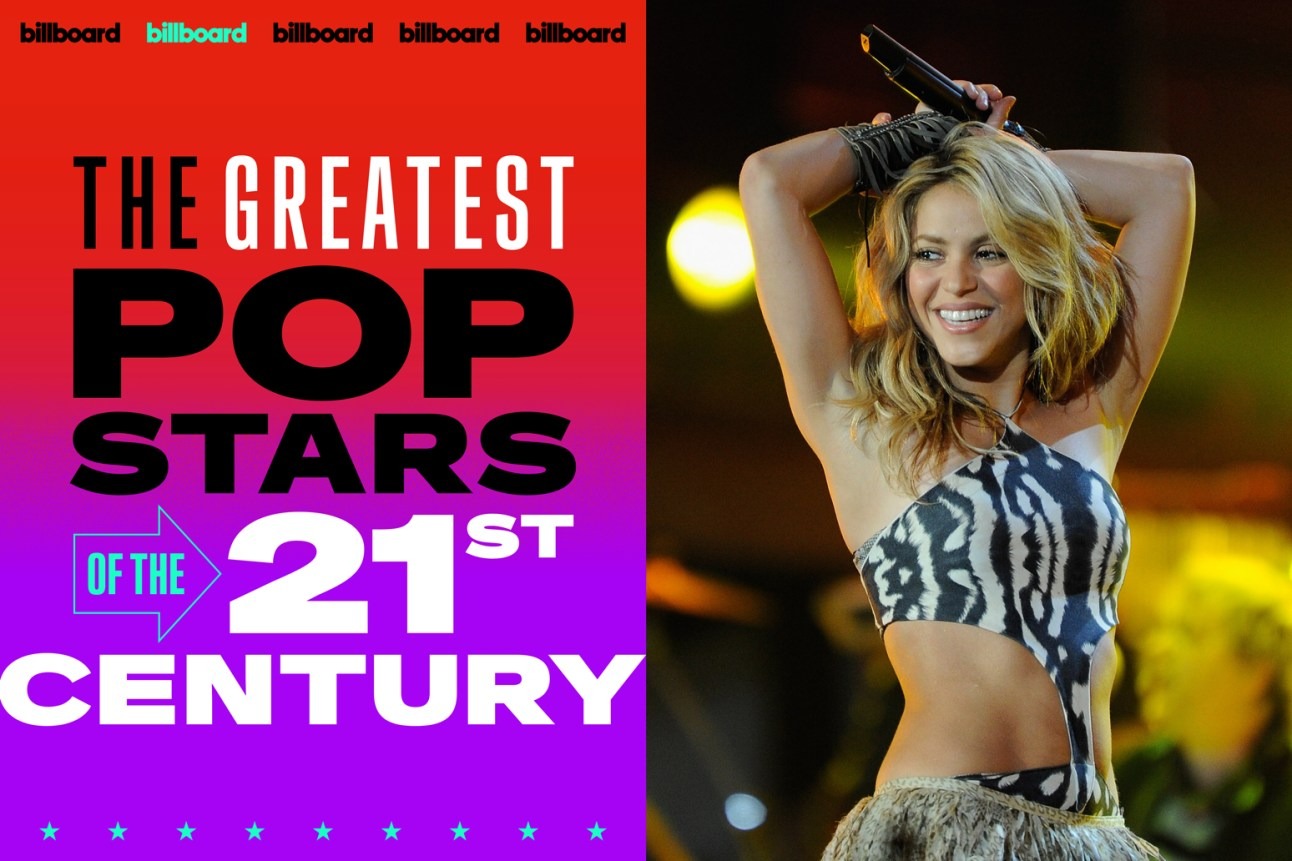With the first quarter of the 21st century coming to a close, Billboard is spending the next few months counting down our staff picks for the 25 greatest pop stars of the last 25 years. We’ve already named our Honorable Mentions and our No. 25, No. 24, No. 23, No. 22, No. 21, No. 20, No. 19, and No. 18 stars, and now we remember the century in Shakira — who transformed Latin pop with her groundbreaking early-’00s crossover, soared to global fame with hits like “Hips Don’t Lie” and “Waka Waka” and influenced a new generation of artists across multiple genres.
At the dawn of the 21st century, Shakira not only emerged as a global musical force, but reshaped how Latin artists crossed into the mainstream, and thrived there. As the millennium turned, the concept of a Latin pop artist dominating worldwide charts in two languages was more aspirational than realistic. This was despite some crossover successes seen in the late ’90s — artists like Jennifer Lopez sang primarily in English, and only a few, such as Selena and Ricky Martin, made significant impacts while performing extensively in Spanish. Yet, Shakira artfully bridged this gap: Blending her Colombian roots with a sharp pop sensibility, she broke through linguistic barriers and set the stage for the breakthroughs enjoyed by non-English speaking artists to follow.

Today, the 15-time Latin Grammy winner is widely considered the most successful female Latin artist of all time, with 95 million records sold over her three-decade career. Many of her songs have become more than hits, but rather pivotal cultural moments that showcase her as a multidimensional superstar. From the Hot 100 No. 1 juggernaut “Hips Don’t Lie” to the FIFA World Cup banger “Waka Waka” and the unapologetic diss track “Shakira: BZRP Music Sessions, Vol. 53” with Bizarrap – released, respectively, across the first three decades of the 21st century – her tracks have become staples at global gatherings, turning sports anthems into pop phenomena and solidifying her status as an international music ambassador.

Fresh off conquering Latin America with her wildly successful third and fourth studio albums — 1995’s Pies Descalzos and 1998’s Dónde Están Los Ladrones? — Shakira, a belly-dancing, guitar-playing, drum-pounding singer/songwriter, transformed her image and sound to kick off the new millennium. Trading her rockera brunette locks for a sexy blonde look, she set her eyes on the English-language market and released the groundbreaking Laundry Service in November 2001. Propelled by timeless hits like “Whenever, Wherever” and “Underneath Your Clothes,” which climbed to No. 6 and No. 9 on the Hot 100, respectively — the album reached a No. 3 peak on the Billboard 200. The LP was both a commercial triumph and a cultural milestone for Latin pop.

In the peak teen-pop era of TRL, Shakira distinctively carved out her niche as an alternative-leaning pop artist — complete with dirty blonde hair with occasional black streaks and braids, and a hippie-rocker look. An exceptional dancer and multi-instrumentalist with a genuine rock edge, she also stood out as a songwriter who uniquely adapted her lyrical style to English — a language she had only recently learned. Her instantly recognizable voice carried a deep, powerful tone laden with emotional cries, reminiscent of Mercedes Sosa’s depth and Alanis Morissette’s raw energy. Yet, it was entirely her own, and her combination of talents and novel approach made Shakira a unique presence in early 2000s pop, challenging conventional norms and paving a new path towards stardom.
As Shakira’s presence on the world stage expanded, she continued to break new ground. Released in June 2005, Fijación Oral, Vol. 1 marked her sixth studio album, and first while on top of the world. Despite her major pop success singing in English on Laundry Service, she still decided to return to singing in Spanish for its follow-up — a risky move that nonetheless paid off both artistically and commercially. Co-produced by luminaries like Gustavo Cerati, Lester Méndez, Luis Fernando Ochoa and José “Gocho” Torres, singles like “No”, “Días de Enero”, “Las de la Intuición” and “La Tortura” with Alejandro Sanz gained wide recognition. Particularly notable was her team-up with the Spanish superstar Sanz, one of the first examples of a major collaboration in Latin music, at a time when such partnerships were rare. Largely praised as one of the best duets of the 2000s, the pop-reggaetón track helped set a precedent for future collaborations across the industry. The latter song became the biggest hit of the set, and the only one that entered the Hot 100.
The album debuted at No. 4 on the Billboard 200, the first all-Spanish set to break to the chart’s top 5. Fijación Oral, Vol. 1 also spent 17 weeks at No. 1 on Top Latin Albums, the most for the Colombian star at the top of the ranking. She quickly followed that set with Oral Fixation, Vol. 2, the English-language counterpart to the Spanish-sung Vol. 1, released that November. Here, Shakira continued to explore new musical territories, venturing more into mainstream pop and rock, marking a noticeable shift from her Latin pop roots and Middle Eastern influences. This album saw her collaborating with iconic musicians such as Carlos Santana on “Illegal” and Gustavo Cerati on “The Day and the Time,” though these tracks, despite the star-studded lineup, didn’t achieve the impact expected.
However, “Hips Don’t Lie,” featuring Wyclef Jean, was added the following year to Shakira’s Vol. 2 in a reissue aimed at boosting the album’s sales, after lead single “Don’t Bother” had underwhelming commercial success. This move helped the album experience a significant revival, boosting it from No. 98 all the way to the top 10 that May. Blending salsa and reggaetón with a Jerry Rivera sample, the song also catapulted to the top of the Hot 100, becoming Shakira’s only No. 1 to date on the all-genre chart and remaining there for two weeks. Despite the album’s rocky start, the LP was ultimately redeemed by the massive success of “Hips,” which has endured as one of the best-remembered pop songs of that entire era (and one of our staff’s top 500 pop songs of all time).The Colombian superstar continued to pour out more records, and released She Wolf in October 9, 2009 — which snarling electropop title track ended up becoming her moniker up to this day, and reached No. 11 on Hot 100 and No. 1 on Dance Club Songs. The album was followed by the more back-to-basics Sale el Sol on 2010, which returned Shakira to the Billboard 200’s top 10, peaking at No. 7. Prior to these, in 2007, she also united with superstar Beyoncé on “Beautiful Liar,” marking an unprecedented collaboration of its time, an American pop icon and a Latin sensation. The song reached No. 3 on the Hot 100.
While she continued to prove her trendsetting and hit-making prowess as a singles and albums artist, she also established herself as a powerhouse in the live performance arena. Her electrifying performance at the 2010 FIFA World Cup in South Africa, where she sang the tournament’s official trilingual anthem “Waka Waka (This Time for Africa),” featuring Freshlyground, became a global call to unity, reflecting the spirit of the tournament and further establishing Shakira as a beloved global icon. (It was also there where she met her former partner, soccer star Gerard Piqué, who she would have two children with and be with for over a decade.) This wasn’t Shakira’s first World Cup performance; she debuted in 2006 with “Hips Don’t Lie” at the closing ceremony in Germany, returned for South Africa, and again in 2014 in Brazil, where she released “La La La” featuring Carlinhos Brown.
Shakira’s musical journey saw continued success with the release of her eponymous 2014 album and 2017’s El Dorado. The former became her highest-peaking album on the Billboard 200, reaching No. 2, and the latter soared to the No. 1 position on Top Latin Albums for five weeks, also dominating the Latin Pop Albums chart for an impressive 63 weeks. Although these achievements maintained her relevance, they couldn’t quite match the explosive impact of her early 21st-century successes. However, notable hits from these albums, like the Shakira-Rihanna collaboration “Can’t Remember To Forget You” and “Chantaje” featuring the then-rising Colombian pop star Maluma, made significant inroads on the Hot 100.
Yet, there was perhaps no greater proof that Latin music cemented its place in American pop culture in the 2020 Super Bowl LIV halftime show, when Shakira and Jennifer Lopez took the world’s biggest stage together on February 2. Shak’s set was thoroughly Latin, featuring a lineup of her Spanish-language hits and dance styles that highlighted her Colombian (and Lebanese) heritage, including champeta and mapalé, an Afro-Colombian dance. This made her performance distinct compared to other Super Bowl halftime shows, aside from Gloria Estefan who performed three times in the ‘90s. The set also featured then-rising global stars Bad Bunny and J Balvin, bringing their own tropical-urbano flair. In contrast, J.Lo delivered more of a razzle-dazzle, high-energy set, reminiscent of a Las Vegas show.
Two years later, Shakira found herself making big headlines again – this time not for her musical achievements or jaw-dropping performances, but for her widely publicized breakup (and tax issues). In early 2022, rumors had swirled that Shakira was ending her 11-year relationship with Gerard Piqué. That June, they confirmed their split, igniting a flurry of tabloid speculation about the soccer player’s infidelity with a younger, 23-year-old woman he reportedly started dating soon after. This personal turmoil attracted intense media scrutiny, with paparazzi besieging Shakira’s home and her children’s school in Barcelona, transforming a private family ordeal into a full-blown media circus.
As much public embarrassment as the relationship fallout caused Shakira, it also helped inspire her most commercially successful period in at least a decade. At the start of 2023, she released the explosive electropop diss track, “Shakira: Bzrp Music Sessions, Vol. 53” with Argentine hitmaker Bizarrap. Her explicit finger-pointing and unapologetic storytelling marked a significant departure from the usual veiled references in breakup songs, as she provided intimate details of her breakup, leaving no room for ambiguity by naming names and addressing personal drama head-on. With bars like “Las mujeres ya no lloran, las mujeres facturan” (“Women don’t cry anymore, women cash in”), the self-proclaimed She Wolf penned a new manifesto of female empowerment, challenging the double standards imposed on Latin women in society. The song became the most viewed clip on YouTube for a Latin track in its first 24 hours, with 63 million views, and marked multiple Billboard milestones, including making Shakira the first female vocalist to debut in the top 10 of the Billboard Hot 100 with a Spanish-language track; it also won song of the year and best pop song at the 2023 Latin Grammys.
The hits kept rolling in, as Shakira scored another Hot 100 top 10 with Karol G on their much-anticipated teamup “TQG.” Together, the two biggest Colombian female pop stars one generation apart delivered the ultimate tabloid-pop hit; Karol G also addressed her tumultuous breakup with Puerto Rican trap star Anuel AA. Both “Vol. 53” and “TKG” reached the Hot 100’s top 10, and “TQG” topped the Billboard Global 200. The song became Karol’s first top 10 hit, and still her only top 10 hit to date.
Shakira essentially spent the rest of the year collecting accolades for her spectacular comeback and overall legacy. In May 2023, Billboard honored Shakira as its first ever Latin Woman of the Year; in July, Premios Juventud gave her its Agent of Change Award. In September, she received the Video Vanguard Award at the MTV Video Music Awards — the first South American artist to receive it — where she also performed a dazzling, 10-minute medley of hits.
Nonetheless, in her 2023 cover story with Billboard, Shakira revealed that for the past seven years, she had been sidetracked by family matters and life in Barcelona, far from music industry action. Her focus shifted following her romantic split, when she cathartically began pouring her heart into her music. Further hits followed: “Te Felicito,” with Rauw Alejandro, climbed to No. 10 on Hot Latin Songs and No. 67 on the Hot 100 in May and June of 2022, respectively; in November, “Monotonía,” with Ozuna (its video shows Shakira’s heart being ripped out and crushed by a shoe), climbed to No. 3 on Hot Latin Songs.
With a gap of seven years since El Dorado — due to Piqué “dragging” her down, in her words — Shak triumphantly released Las Mujeres Ya No Lloran in March 22, 2024. The album, her 12th studio effort, showcased a hodgepodge of sounds, from infectious Afrobeats to soulful bachata, Tex-Mex rhythms and even a return to her rock roots. It quickly garnered critical acclaim, also debuting at No. 1 on both the Top Latin Albums and Top Latin Pop Albums charts. This milestone marked Shakira as the first woman to top these charts across four decades. Continuing her journey as a monumental force, Shakira is set to return to the stage with Las Mujeres Ya No Lloran World Tour, kicking off November 2, on her first tour since 2018 with El Dorado World Tour.
Shakira’s early foresight in blending Spanish and English within her music paved the way for today’s artists, who now benefit from the doors she helped to open. Reflecting on the music industry today, superstars like Bad Bunny, J Balvin and Karol G navigate high-profile careers entirely in Spanish, a testament to how far the industry has evolved from the days when bilingual or English-language offerings were deemed necessary for true crossover success.

With the tremendous and more recent success of superstars like Bunny, Balvin, Karol, and also música mexicana stars like Fuerza Regida and Grupo Frontera — both collaborators on her latest album — their momentum has also helped legacy Latin artists like Shakira maintain their relevance and influence amid the surge of Latin music, currently the fastest-growing genre in the U.S. With the 2024 Latin Grammy nominations announced on Tuesday (Sept. 17), Shakira continues to garner recognition: She is currently nominated for three awards, including album of the year for Las Mujeres Ya No Lloran, song of the year for the Tex-Mex-leaning “(Entre Paréntesis)” with Grupo Frontera, and best Latin electronic music performance for “Bzrp Music Sessions, Vol. 53 (Tiësto Remix).”
Shakira’s saga, marked by groundbreaking successes and personal challenges, epitomizes the journey of a true pop titan in the 21st century. Charting a path that brought Latin rhythms into mainstream global consciousness, her countless hits and charismatic stage presence have not only defined her career but also substantially influenced the current musical landscape. Moreover, her resilience and adaptability exhibit a model of empowerment and artistic authenticity. By weaving through personal hardships and consistently emerging on top, Shakira has not merely navigated the complex terrains of global pop music but has left an indelible mark on it. As we celebrate her as one of the greatest pop stars of this era, Shakira remains a pillar of innovation and resilience. After all, her hits don’t lie.